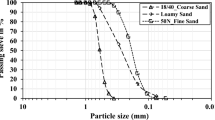Abstract
This paper presents a numerical solution approach for an existing model for simulating transport and biodegradation in saturated porous media. The discrete approximation makes use of an appropriate blending of mixed-hybrid finite-element and shock-capturing finite-volume schemes. The model is applied for simulating enhanced-bioremediation of highly heterogeneous porous media contaminated by organic pollutants. Injection of water enriched in dissolved oxygen (DO) is considered for accelerating contaminant degradation and concentration of both organic pollutant (substrate) and DO. Heterogeneity is found to produce pools of contaminants which strongly affect DO delivery and, then, the degradation of the organic contaminant. A set of numerical results on representative situations illustrates the effectiveness and the robustness of the present approach. The computational efficiency of the present approach is also estimated in terms of CPU costs and memory requirements.
Similar content being viewed by others
References
Widdowson, M. A., Molz, F. J. and Benefield, L. D.: A numerical transport model for oxygen-and nitrate-based respiration linked to substrate and nutrient availability in porous media, Water Resour. Res. 24(9) (1988), 1553–1565.
National Research Council.: In Situ Bioremediation: When Does It work? National Academy Press, Washington, D.C., 1993.
Molz, F. J., Widdowson, M. A. and Benefield, L. D.: Simulation of microbial growth dynamics coupled to nutrient and oxygen transport in porous media, Water Resour. Res. 22(8) (1986), 1207–1216.
Kindred, J. S and Celia, M. A.: Contaminant transport and biodegradation: 2. conceptual model and test simulations, Water Resour. Res. 25(6) (1989), 1149–1159.
Frind, E. O., Duynisveld, W. H. M., Strebel, O. and Boettcher, J.: Modeling of multicomponent transport with microbial transformation in groundwater: the furherg case, Water Resour. Res. 26(8) (1990), 1707–1719.
Malone, D. R., Kao, C. M. and Borden, R. C.: Dissolution and biorestoration of nonaqueous phase hydrocarbons: Model development and laboratory evaluation, Water Resour. Res. 29(7) (1993), 2203–2213.
Wood, B. D., Dawson, C. N., Szecsody, J. E. and Streile, G.: Modeling contaminant transport and biodegradation in a layered porous media system, Water Resour. Res. 30(6) (1994), 2833–1845.
Kinzelbach, W., Schafer, W. and Herzer, J.: Numerical modeling of natural and enhanced denitrification processes in aquifers, Water Resour. Res. 27(6) (1991), 1123–1135.
Zysset, A., Stauffer, F. and Dracos, T.: Modeling of reactive groundwater transport governed biodegradation, Water Resour. Res. 30(8) (1994), 2423–2434.
Wood, B. D., Ginn, T. R. and Dawson, C. N.: Effects of microbial metabolic lag in contaminant transport and biodegradation modeling in a layered porous media system, Water Resour. Res. 31(3) (1995), 553–563.
Freeze, R. A. and Cherry, J. A.: Groundwater, Prentice-Hall, New Jersey, 1979.
Gallo, C. and Manzini, G.: A mixed finite element/finite volume approach for solving biodegradation transport in groundwater, Int. J. Numer. Meth. Fluids, (1997), in press.
Chen, Y. M., Abriola, L. M., Alvarez, P. J. J., Anid, P. J. and Vogel, T. M.: Modeling transport and biodegradation of benzene and tolune in sandy aquifer material: Comparisons with experimental measurements, Water Resour. Res. 28(7) (1992), 1833–1847.
Tracy, J. C., Erickson, L. E. and Davis, L. C.: Rate limited degradation of hazardous organic contaminants in the root zone of a soil, In: 86th Annual Meeting & Exhibition, pp. 93-WA-89.02, Denver, Colorado, June 1993. Air & Waste Management Association.
Tracy, J. C., Ramireddy, H., Erickson, L. E. and Davis, L. C.: Effects of climatogical variability on the performance of vegetative systems in remediating contaminated soil, In: 87th Annual Meeting & Exhibition, pp. 94-WA-86.01, Denver, Colorado, June 1994. Air & Waste Management Association.
Chiang, C. Y., Wheeler, M. F. and Bedient, P. B.: A modified method of characteristics technique and mixed finite elements method for simulation of groundwater solute transport, Water Resour. Res. 25(7) (1989), 1541–1549.
Raviart, P.-A. and Thomas, J. M.: A mixed finite element method for second order elliptic problems, In: I. Galligani and E. Magenes (eds), Mathematical Aspects of the Finite Elements Method, Lecture Notes in Math. 606, Springer-Verlag, New York, 1977.
Chavent, G. and Roberts, J. E.: A unified physical presentation of mixed, mixed-hybrid finite elements and standard finite difference approximation for the determination of velocities in waterflow problems, Adv. Water Resour. 14(6) (1991), 329–348.
Roberts, J. E. and Thomas, J. M.: Mixed and Hybrid Finite Element Methods, vol. III, Finite Elements Methods, P. G. Ciarlet and J. L. Lions (eds), North-Holland, Amsterdam, 1990.
Bailey, J. E. and Ollis, D. F.: Biochemical Engineering Fundamentals, McGraw-Hill, New York, 1977.
Brezzi, F. and Fortin, M.: Mixed and Hybrid Finite Element Methods, Springer-Verlag, Berlin, 1992.
Brezzi, F.: On the existence, uniqueness and approximation of saddle point problems arising from Lagrangian multipliers, R.A.I.R.O. Anal. Numer. 8 (1974), 129–151.
Harten, A., Osher, S. and Chakravarthy, S. R.: Some results on uniformly high-order accurate essentially nonoscillatory schemes, Appl. Numer. Math. 2 (1986), 347–376.
Harten, A., Engquist, B., Osher, S. and Chakravarthy, S. R.: Uniformly high-order accurate essentially nonoscillatory schemes, iii. Journal of Computational Physics 71 (1987), 231–303.
Sweby, P. K.: High resolution schemes using flux limiters for hyperbolic conservation laws, SIAM-J. Numer. Anal. 21 (1984), 995–1011.
Barth, T. J.: Aspects of unstructured grids and finite volume solvers for the Euler and Navier-Stokes equations, Proc. of the AGARD-VKI Lecture Series on Unstructured Grid Methods for Advection Dominated Flows Dynamics, AGARD Report 787, 1992.
Ewing, R. E. (ed.): The Mathematics of Reservoir Simulation, SIAM, Philadelphia, 1983.
Chavent, G. and Jaffré, J.: Mathematical Models and Finite Elements for Reservoir Simulation, North-Holland, Amsterdam, 1986.
Wattenbarger, R. C.: Simulation of Tracer Flow Through Heterogeneous Porous Media, PhD thesis, Stanford University, Department of Petroleum Engineering, School of Earth Sciences, 1993.
Sciabica, M. G.: Validazione Dei Modelli Concettuali e Matematici Degli Aquiferi con i Dati Idrogeologici e Idrogeochimici dell Reti di Monitoraggio, PhD thesis, Dept. di Ingegneria del Territorio, Univ. of Cagliari, Italy, 1994.
Author information
Authors and Affiliations
Rights and permissions
About this article
Cite this article
Gallo, C., Manzini, G. 2-D Numerical Modeling of Bioremediation in Heterogeneous Saturated Soils. Transport in Porous Media 31, 67–88 (1998). https://doi.org/10.1023/A:1006571720765
Issue Date:
DOI: https://doi.org/10.1023/A:1006571720765




